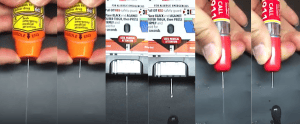 Photo: Dr. Julie Brown
Photo: Dr. Julie Brown Experts weigh in on epinephrine auto-injector needle length and dosing debate after coroner’s inquest following tragic death.
As board-certified allergists who are expert in the treatment of anaphylaxis, we wish to express serious concerns with the conclusions offered in the U.K. Coroner’s inquest into the tragic death of 15-year-old Natasha Ednan-Laperouse, who died following a severe allergic reaction on an airplane.
We thank the inquest for raising the importance of improving the labeling of foods for allergens. However, we cannot support Coroner Dr. Sean Cummings’ conclusion that the length of needle in the EpiPen epinephrine auto-injector is “inherently unsafe,” nor that the dose of epinephrine is “inadequate” for anaphylaxis and that these factors raise safety concerns.
In North America, EpiPens and other epinephrine auto-injectors (EAIs) that are marketed to those weighing over 66 pounds all use the same needle length and dosage. We wish to clarify that these EAIs are considered safe and effective treatment for anaphylaxis in the vast majority of allergic patients. They provide appropriate and potentially lifesaving treatment for many thousands of patients with allergies each year.
Sadly, there are still rare but tragic deaths from anaphylaxis. While the reason anaphylaxis sometimes progresses rapidly and becomes lethal despite treatment with epinephrine deserves further study, we do know that certain actions are protective. Early treatment of an allergic reaction with epinephrine increases the chance of a good outcome. All patients with food or sting allergies should have an emergency care plan and know what signs and symptoms warrant treatment using their EAI. Having asthma symptoms under good control also makes a difference.
In the following article, Dr. Julie Brown, whose research has focused on the design and safety of EAI devices, details the science behind the EAI needle length, dose, and drug delivery.
–Dr. Susan Waserman, Dr. James R. Baker Jr., Dr. Wayne Shreffler, Dr. Anne Marie Ditto, Dr. Julia Upton, Dr. T. Ted Song.
Assessing Needle Length and Other Features of Current Epinephrine Auto-Injectors
By Dr. Julie Brown
Coroner Dr. Sean Cummings’ statements that the two 0.3 mg EpiPen devices 15-year-old Natasha Ednan-Laperouse had received raised “serious safety concerns,” with needle lengths that were “inherently unsafe,” appear to have been informed by guidelines issued by the U.K. Resuscitation Council, as well as the opinion of a consultant allergist, Dr. Alexandra Croom, who testified at the inquest.
These conclusions from the inquest into Natasha’s death have not surprisingly alarmed patients with allergies who carry EpiPens and other similar epinephrine auto-injector (EAI) devices. In the United States, the maximum approved auto-injector dose is 0.3 mg, and the three marketed devices all have similar needle lengths for a given dose (approximately 0.6 inches for 0.3 mg devices, prescribed for patients weighing over 66 pounds).
First, it is important to note that the statements about needle length in the U.K Resuscitation Council Guidelines for Healthcare Providers on the Emergency Treatment of Anaphylactic Reactions outline needle lengths that are appropriate for administering epinephrine with a needle and syringe, not with an auto-injector. Secondly, while these guidelines recommend an adult dose of 0.5 mg, the guidelines again specify that this is for healthcare providers, and do not apply to auto-injector use.
To better understand how EAI devices have been designed the way they have, we need to step back and review the science. This article aims to review both the laboratory and clinical evidence regarding optimal needle length, epinephrine dose and device safety.
Needle Length
The depth of epinephrine delivery by auto-injector depends on three things: needle length, tissue compression and propulsive force. If an EAI was triggered at skin level without any compression of soft tissues, the needle tip would not reach muscle in many patients. However, that’s not how they’re designed. The force to activate these devices compresses skin and soft tissue and decreases the distance from skin to muscle. The force injecting the drug pushes it well past the needle tip.
 Dr. Julie Brown
Dr. Julie Brown Studies taking just two of these three factors – needle length and this tissue compression – into account have estimated whether or not a 0.6-inch needle would be too short to reach muscle, would reach muscle or would be too long and hit bone. In one study by Dreborg et al of children over 66 pounds, in 9% the needle would be too short and would not reach muscle and in 3% it would risk injecting into bone. Two separate studies showed that in 28% of women the needle would be too short and would not reach muscle, while one of these studies showed that in 0% of men the needle would be too short.
However, these studies did not consider the role of propulsion – the force with which epinephrine is pushed out of the needle tip. It is clear that EAIs push the drug well past the needle tip, and much farther than when it is injected with a syringe. There is a study in the U.K. which suggested that fascia, the tough stuff around muscle, forms an impenetrable barrier to the passage of drugs that are injected short of the muscle. However, this study was done using dead pig models, not living tissue, and there is blood flow through fascia in living tissue that isn’t present in dead tissue.
Furthermore, needle-free devices exist that can push medications all the way from the skin to muscle, including through fascia. There is also a study in humans where a dye molecule similar in size to epinephrine was injected using an EAI, and imaging studies showed that it was able to travel through fascia in muscle.
The bottom line is that while more evidence regarding optimal needle length would be useful, the needles of these devices are likely long enough for the vast majority of patients. It would be ideal to have a wider range of devices, with needle lengths tailored to the normal-weight versus obese patient. However, with only a single length available for older children and adults, increasing the EAI needle length would help some patients and potentially hurt others: it might be advantageous for some obese patients, but it would increase the risk of injection into bone in smaller and thinner patients, particularly children just reaching the weight cut-off of 66 pounds, and underweight adults. Increasing needle length might also increase the risk of injury, particularly in children.
Epinephrine Dose
There is surprisingly little information on what dose of epinephrine is optimal in patients in anaphylaxis. The standard FDA-approved dose and route for epinephrine is 0.01 mg/kg for children weighing 30 kg (66 pounds) or less, with a maximum of 0.3 mg in children and teenagers, and 0.5 mg in adults. EAI doses of 0.1 mg, 0.15 mg and 0.3 mg match this 0.01 mg/kg ideal as closely as possible, across a range of child weights.
The evidence to support the dose recommendations is scant: it’s based on other uses of epinephrine. Studies have been done that compare injected dose with the amount of medication detected in the bloodstream. Yet, there is little information on dose compared with resolution of symptoms, or side effects.
However, history and experience are important to consider. This dosing strategy is supported by over 40 years of clinical practice. It appears to work well and with an excellent safety record.
Site of Injection
Dr. Croom also reported during the inquest that the second EpiPen may have been ineffective because it was administered in the same part of the thigh as the first, where blood vessel constriction from the first injection may have restricted blood flow and prevented the rapid dispersal of epinephrine following the second injection. While it is true that epinephrine briefly causes blood vessel constriction at the injection, it seems highly unlikely that two injections would be delivered so close together in a large thigh muscle that this would significantly impact drug delivery.
However, it is not unreasonable to alternate thighs when multiple injections are given during an allergic reaction, or move slightly up or down the thigh to ensure the medication is not injected in the identical spot. More importantly, however, is that doses of epinephrine can be continued until medical help is available.
The Proof is in the Pudding
The best support for current EAI needle length and dose is what is happening with real patients. These devices appear to be working well, relieving symptoms effectively and saving lives. In a recent Canadian study, only 20% of patients managing anaphylaxis outside the hospital needed to use more than one EAI. When children alone are considered, only 12% need to use more than one EAI. The chances of needing a second device are similar in normal weight and obese patients, and fatalities are not higher in obese patients. All these findings indicate that existing devices, with current needle lengths and doses, are working well across a range of patient ages and sizes.
 Natasha Ednan-Laperouse
Natasha Ednan-Laperouse Terrible events such as the unfortunate death of Natasha Ednan-Laperouse are thankfully rare, and are often associated with a delay in the use of any epinephrine when symptoms warrant it. Better food labeling can prevent these events from happening in the first place. The best defense is good preparation and carrying two EAI devices, and not hesitating to use them when symptoms warrant it. More research is needed on optimal dosing of epinephrine, and ideal needle length for optimal drug delivery. EAI device manufacturers should have an easier FDA-approval path to adding new devices to their portfolios, so they can better meet the needs of the diverse population of patients they serve.
In the meantime, allergy patients are well advised to continue to carry their EAI at all times, and should feel confident that they are capable of delivering their life-saving medication to the bloodstream when needed.
Dr. Julie Brown is a pediatric emergency medicine physician at Seattle Children’s Hospital and associate professor at the University of Washington. She has published a review of issues related to EAI dose and needle length, and has authored a study investigating EAI injuries that led to changes in instructions for use.
Dr. Susan Waserman is a professor of medicine in the division of clinical immunology & allergy at McMaster University Department of Medicine in Hamilton, Ontario.
Dr. James R. Baker Jr. is CMO of Food Allergy Research & Education (FARE) and director of the Mary H. Weiser Food Allergy Center at Michigan Medicine, University of Michigan.
Dr. Wayne Shreffler is an associate professor of pediatrics at Harvard Medical School and chief of pediatric allergy at MassGeneral Hospital for Children.
Dr. Anne Marie Ditto is an associate professor of medicine at Northwestern University’s Feinberg School of Medicine in Chicago, Illinois.
Dr. Julia Upton is an assistant professor of pediatrics in the the division of allergy & clinical immunology at the University of Toronto and the Hospital for Sick Children in Ontario.
Dr. T. Ted Song is associate professor of medicine in department of medicine, division of allergy and infectious diseases at University of Washington School of Medicine in Seattle, Washington.
Disclosures: Dr. Waserman has received a research funding and consulting fees from Pfizer Canada.





